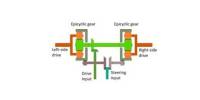Although American microchip manufacturing facilities can fit billions of data processing transistors onto a tiny silicon chip, a crucial component, essentially a “clock,” that is required to schedule the functioning of those transistors must be produced separately, which compromises chip security and the supply chain.
By addressing the weak spot and enabling new functionality through improved integration, a novel method is used to create customized transistors that serve as the foundation of this timing device.
“You would have one chip that does everything instead of multiple chips, multiple fabrication methods and multiple material sets that must be integrated often overseas,” said Dana Weinstein, a Purdue University professor of electrical and computer engineering, who is developing acoustic resonators with the processes used to produce industry-standard fin field-effect transistors (FinFETs).
“There’s a need for America to advance its capabilities in chip manufacturing, and an advance of this nature addresses multiple concerns in supply chain, national security and hardware security. By moving the whole clock inside the processor, you harden the device against clock-glitching attacks, and you enable new functionality such as acoustic fingerprinting of the packaged chip for tamper detection.”
Modern microelectronics’ foundational FinFETs are voltage-activated on/off gates, just like all transistors. A FinFET, as the name suggests, conducts electricity along a semiconducting fin that passes through the gate.
The fin does not conduct electricity when it is closed, or off. An electric charge is created in the fin by a voltage given to the top of the gate, which enables electricity to flow in an open, or on, state.
However, in order for microprocessors, sensors, and radios which are utilized in all electronic devices to function, transistors must be synchronized. Devices that achieve this are based on sound, specifically the resonance frequency that certain structures create, much as how a glass bowl may produce a particular note when tapped.
When the microprocessor and other components are done, so is the resonator. It doesn’t have to undergo further fabrication or be sent somewhere else for integration with a separate microprocessor chip.
Jackson Anderson
This so-called acoustic resonator’s regular repeating wave functions as a cadence that is integrated into a larger microelectromechanical system and used to keep time. Current commercial microelectromechanical resonators have to be created separately and then assembled with microchips for use because they can’t be made using a conventional chip fabrication technique.
The creation of an acoustic resonator using the materials and fabrication methods already available in a typical complementary metal oxide semiconductor chip fab is Weinstein’s discovery. Her research team describes its most cutting-edge design to date in a recent publication published in Nature Electronics.
Using a commercial process run at the GlobalFoundries Fab 8 facility in New York and described in the GlobalFoundries 14LPP FinFET technology design manual, team members fabricated a specialized set of FinFETs capable of producing a frequency in the range of 8-12 gigahertz, which exceeds the typical native clock rates of microprocessors.
The elegant solution essentially repurposes data processing transistors into a timing device.
“With our approach, the chip fab runs this device through the same process they would use for a computer’s central processing unit or other application,” said Jackson Anderson, a Purdue graduate student in electrical and computer engineering and first author on the Nature Electronics paper.
“When the microprocessor and other components are done, so is the resonator. It doesn’t have to undergo further fabrication or be sent somewhere else for integration with a separate microprocessor chip.”
All transistors can be utilized as capacitors to store and release a charge, even though the on or off states of a transistor typically direct current to act as the binary 0s and 1s. Weinstein’s team accomplishes this by squeezing and releasing a tiny layer of dielectric material between the fin and the gate using arrays of “drive” transistors.
“We’re squeezing those layers between the gate and the semiconductor, pushing and pulling on that thin region between the gate and the fin,” Jackson said. “We do this alternately on adjacent transistors one compressing, one stretching building vibrations laterally in the device.”
The driving transistors are designed and sized to direct and amplify the vibrations so that they pile up into a certain resonant frequency. This causes the semiconductor material in a nearby group of “sense” transistors to be stretched and compressed, which modifies the properties of a current flowing across those transistors and converts the vibration into an electrical signal.
“Every single piece of high-performance electronics that you have uses FinFETs,” Weinstein said. “Integrating these functions advances our microelectronics capabilities beyond just digital microprocessors. If the technology changes, we can adapt, but we would be moving forward with an integrated microprocessor system.”
















